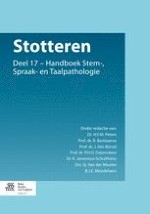Gepubliceerd in:
2014 | OriginalPaper | Hoofdstuk
De etiologie van stotteren
Theorieën en modellen december 1997
Samenvatting
Stotteren is een storing in het ritme van de spraak, waarbij de spreker precies weet wat hij/zij wil zeggen maar dat voor het moment niet kan, vanwege onwillekeurige – stille en hoorbare – herhalingen en verlengingen van spraakklanken (who, 1977).
